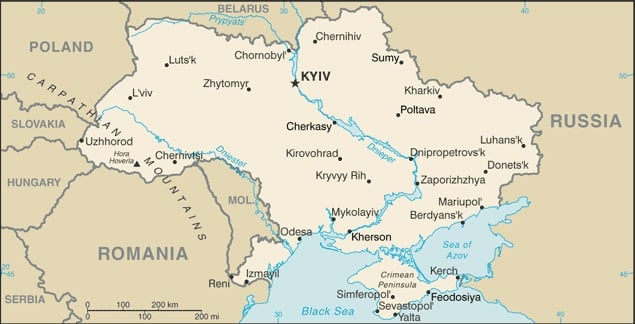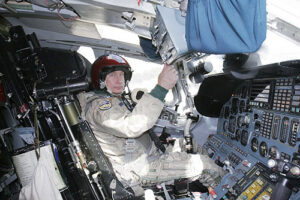By REUBEN JOHNSON

KYIV: Ukrainian citizens are studying maps to local bomb shelters as Russia builds up its forces at land and sea, while the US imposes sanctions and issues stern statements. But the question remains: what are Russian President Vladimir Putin’s objectives in this crisis. What, people are asking, does the former KGB lieutenant colonel hope to gain by threatening a full-scale invasion of his neighbor and former vassal state?
Whether or not war between Ukraine and Russia breaks out or not, the fact remains that Putin has a deep-seated desire “to make Russia great again” — if need be by invading its neighbors and destabilizing the entire region. Understanding that overriding imperative of Putin’s rule may be the singular element in formulating policy vis-à-vis Moscow.
Russia had been widely expected to invade Ukraine within a matter of days. This speculation followed weeks of escalating tensions between the two nations, an increase in the number of air space violations by Moscow’s military and an overall sense in the capital that armed conflict could break out at any time. The buildup of Moscow’s forces on the border is the largest since the 2014 Russian seizure of Crimea.
Speaking to Deutsche Welle, the Ukrainian Ambassador to the UK and former Foreign Minister Vadym Prystaiko described the degree to which the level of fear in Ukraine has increased in recent days.
“What we fear the most is a full-scale invasion of Ukraine. Today, Kyiv authorities have publicized the map of the bomb shelters to the population, just in case. People started buying imperishable foods. So, that’s how high expectations and the fears are in Ukraine.”
What has been credited with holding back (for now) such a nightmare scenario is an 11th-hour phone call between Putin and US President Joe Biden on April 13. The two leaders reportedly agreed to a bilateral summit in coming months to discuss how to defuse these tensions. The next day, EUCOM commander USAF General Tod Wolters told the House Armed Services Committee that there was only a “low to medium” risk of Russia launching an invasion. (Of course, generals and other leaders have often misjudged the intentions of an adversary.)
The expanding presence of Russia’s military on the border with Ukraine both in the Eastern Donbas region and Crimea – as well as a parallel naval buildup – has observers wondering just how long that “low-to-medium” atmosphere will continue to be the case.
Moscow’s military presence at Ukraine’s borders is projected to “reach 56 battalion tactical groups with 110,000 troops,” testified Ukraine Defence Minister Andrii Taran before the European Parliament’s Security and Defense Subcommittee. The MoD chief also assessed Russia’s naval deployments in the Black and Azov Seas as designed to “block important trade routes in international waters.” The lion’s share of Ukraine’s $103 billion in foreign trade last year moved by commercial sea freight.
According to the Jamestown Foundation’s Eurasia Daily Monitor, the Russian Navy will have assembled an armada of 50 warships by the end of April – thanks to additional ships arriving from the Caspian and Baltic fleets. And the ships from the Baltic and Caspian units are equipped to stage amphibious landings on the Ukrainian cost.
A Bad Neighborhood
The current crisis with Ukraine is a continuation of a long post-Soviet Russian tradition of unhappy interactions with former USSR republics it borders:
“I think the countries to the north of Afghanistan such as Tajikistan, Kyrgyzstan and Uzbekistan are also going to be worried about the flows of refugees and perhaps fighters to the north. All of them will see what happens after we leave, how the United States postures itself, and then they’ll decide what to do,” Gen. McKenzie said this week.
In 2007, Russian hackers waged a cyber war on the tiny Baltic nation of Estonia for 22 days.
In 2008, Russia invaded Georgia; it still occupies two northern provinces that were taken in the initial phases of the fighting.
Russia’s small Slavic neighbor, Belarus, remains locked in a military alliance with Russia that Moscow controls – with the country periodically occupied by Russian troops during war-game exercises.
The Transnistria region of the Republic of Moldova has remained independent – largely due to support from Russia in the 1990s for a separatist movement.
But it is Ukraine that has been the number one target of Putin’s new-age imperial ambitions. He has consistently refused to recognize the legitimacy of Ukraine’s independence, stating Ukraine is not a “real country” and that it will always be part of the “Russian world.” This has prompted some notable attempts by Putin to force Ukrainians to comply with his wish that they continue to be a compliant colony of Moscow.
Most notable was Russia turning off the gas valve to Ukraine in the winter of 2006. This occurred a year after a January 2005 re-run of a previously fraudulent presidential vote rejected then-Ukraine PM Viktor Yanukovych, the pro-Moscow candidate Putin favored. Four years later, Putin won when the former PM finally managed to become Ukraine’s president.
Yanokovych began openly taking actions that benefitted Russia far more than his own population. Two major examples were his brute-force restructuring of Ukraine’s defense industrial sector to better integrate it with Russian industry and then steamrolling parliament into scrapping plans for Ukraine to join the NATO alliance.
In late 2013, a last-minute reversal of Yanukovych’s promise to put Ukraine on the path to EU membership resulted in the Winter on Fire. This Maidan Revolution forced the pro-Moscow president to flee the country in early 2014. Shortly after his abdication, Russia invaded Crimea, which is still occupies, and began a now seven year-long war in the eastern Donbas region of Ukraine that continues at a low boil to this day.

Vlad Putin in cockpit of a TU-160 Bomber over Venezuela.
Putin’s Objectives
Putin’s near-obsession with Ukraine remaining under Moscow’s control is prompted by several factors.
The first and foremost of these is that Ukraine is the centerpiece of his 30-year-long crusade to compensate for the collapse of the USSR, spelling the end of Russia as an imperial power.
The late Zbigniew Brzezinski, the Polish-American statesmen and former National Security Advisor in Carter Administration, once observed: “It cannot be stressed enough that without Ukraine, Russia ceases to be an empire, but with Ukraine suborned and then subordinated, Russia automatically becomes an empire.”
Secondly, there is the economic decline of Russia. Already in a financial shambles due to years of low oil prices, it is now reeling from the impact of COVID-19 and a host of other ills; the year 2020 saw an 11-year low in economic performance. These conditions have produced increasing numbers of anti-Putin protests in which he is openly denounced as a thief and a criminal.
This has all but destroyed any of Putin’s remaining possibilities to offer an attractive “eastern alternative” to Ukraine’s aspirations to join the EU. Ukraine is also not alone in wanting to remain outside Moscow’s orbit. In other bordering republics, a series of pro-Moscow leaders have either been removed or have suffered considerable setbacks.
This has fed into Putin’s other phobia – born in his days in the former East Germany where he witnessed the collapse of the Berlin Wall, followed later after his return to Leningrad by the humiliating end of the USSR itself. In the words of Russian analyst Masha Gessen, these events cemented “Putin’s view that a large number of people in the streets signals the end of a regime.”
Although they will not admit it publicly, Putin and his cronies have long ago realized that the regime in Russia is going to be progressively harder to sustain – and may even eventually collapse. Thus, their goal for some time now has been to “undermine the EU political project because it goes against their vision of the world,” said Tara Varna, the head of the European Council on Foreign Relations (ECFR) in Paris, in a 2019 interview.
Another ECFR analyst, Gustav Gressel, stated that Russia sees Europe “is too weak to be a superpower” and won’t survive. “Russia is just waiting for their time to come when the EU and NATO collapse,” he explained
But events of the past two years have shown no indicators that either the EU or NATO will collapse before Putin’s ruling order does. This appears to have left the use of military force as Putin’s only remaining option. It is what keeps Putin massing troops and naval vessels around Ukraine’s borders despite the country presenting no military threat to Russia. The threat Ukraine represents is that it will still exist as a state and as a people with a national identity, long after Purin’s rule has collapsed.
No comments:
Post a Comment